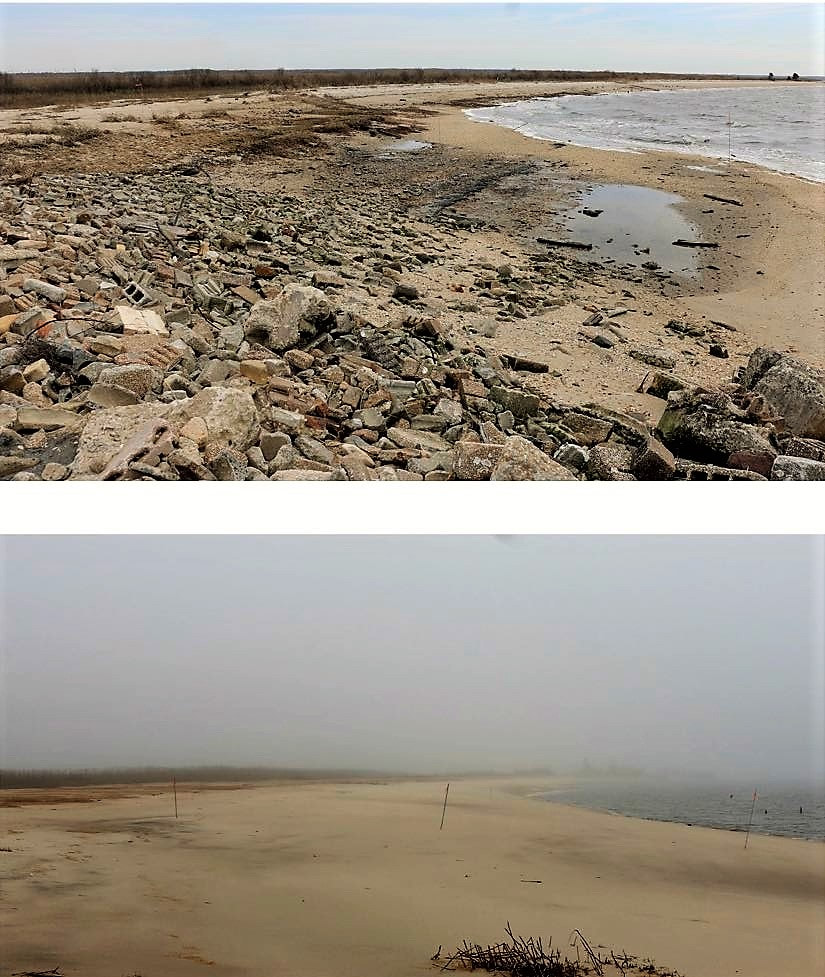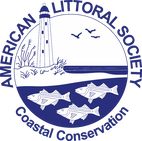|
Thompsons Beach, before and after restoration. Photo provided by LJ Niles Associates. The American Shore & Beach Preservation Association (ASBPA) has named Thompsons Beach, on New Jersey's Delaware Bayshore, one of the best restored beaches in the United States. The American Littoral Society and partners restored Thompsons Beach in the aftermath of Hurricane Sandy. According to the ASBPA, the Thompsons Beach project was recognized because it had both environmental and economic benefits, used a science-based process, and showed the benefits of public/private partnerships. "Thompsons Beach was selected because it demonstrated how beach nourishment can be successfully used to enhance both ecosystem and recreational benefits" according to the ASPBA. "This project used a science-based restoration process that not only provided the resources to sustain ecological benefits to horseshoe crabs and the federally listed red knot; by way of adaptive management, but also illustrated the power of a public/private trust, its ability to overcome regulatory and logistical obstacles, and still provide needed resiliency for the natural and human-built environs. Additionally, the project enhanced the beach by removing 965.5 tons of concrete rubble, wood, and other debris prior to sand placement."
In 2012, Hurricane Sandy dumped tons of debris onto Delaware Bay beaches and stripped them of sand. The immediate concern was that nearly 70 percent of horseshoe crab beach habitat was destroyed and its loss imperiled not only the horseshoe crabs that spawn there, but also shorebirds like the Federally listed red knot, which stop on those beaches each spring to feed on crab eggs before flying to their nesting grounds in the Canadian Arctic. The birds and crabs help fuel a multi-million-dollar annual ecotourism industry in New Jersey's Bayshore region. Almost immediately, the American Littoral Society and Conserve Wildlife Foundation of New Jersey - working with a wide range of partners, including federal and state agencies, county and local municipalities, business groups, and private foundations - began work to restore beaches along the Delaware Bayshore. "It was a crisis response; we were racing against a firm deadline of the horseshoe crabs arriving on the beach," said Tim Dillingham, executive director of the American Littoral Society. "But we were also intent on rebuilding habitats along Delaware Bay in order to strengthen the ecology, communities, and economy of that area. We set out to build partnerships and relationships that would invest everyone in working for a healthy and resilient Delaware Bay." With funding from the US Fish and Wildlife Service and the National Fish and Wildlife Foundation, the Littoral Society and partners expanded the scope of the project, removing rubble and replacing sand on several beaches. Initial restoration of Thompsons Beach took place in 2015. Since then, the Society has continued to do enhancement and monitoring of the beaches. As part of that, the Society has used volunteers to build inter-tidal reefs off the restored beaches in order to reduce the effect of future storms and prevent sand erosion. To enter the Best Restored Beach competition, coastal communities nominated their projects for consideration, and an independent panel of coastal managers and scientists selected the winners. Judging was based on three criteria:
According to Lee Weishar, Ph.D., chair of the Best Restored Beach Committee responsible for making the selections: "I look for commitment and dedication to the project. I want the applicant to make me love his or her beach." The ASBPA honors restored beaches because of what they do for the coastal environment and US economy. Among those benefits are:
"We here at ASBPA take that love of the coast very seriously," said ASBPA President Tony Pratt. "We honor the efforts that go into managing and, when necessary, rebuilding the beaches that are in the hearts of so many vacationers." "This year's Best Restored Beach winners represent a wide variety of beach types that offer unique and varied attributes. I congratulate the winners for their hard work and for the beautiful beaches they have protected and enhanced," said Pratt. "For more than 50 years, beach restoration has been the preferred method of shore protection in coastal communities. Beach restoration is the process of placing beach-quality sand on dwindling beaches to reverse or offset the effects of erosion." Other 2018 winners are Dare County Beaches in North Carolina, the Galveston Texas Seawall Beach, TX, California's Cardiff Beach, and New York's Sag-Bridge Beaches. The American Littoral Society is a member-supported, coastal conservation non-profit that promotes the study and conservation of marine life and habitat, protects the coast from harm and engages communities to do the same through work in education, advocacy, and conservation. Founded in 1961, the American Littoral Society has regional offices in New Jersey, New York and Florida. For more information, visit www.LittoralSociety.org. Comments are closed.
|
Archives
July 2024
Categories
All
|


